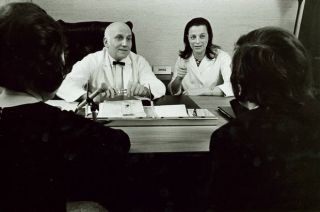Orgasm
Have a Nice (Orgasm) Day
On International Orgasm Day—a celebration of a pioneer in the field
Posted July 31, 2013

Virginia Johnson

Masters and Johnson
Every second of every day, across the face of our planet, there are 18000 male orgasms, but only 4.4 births. A mischievous person might use this level of obvious inefficiency as evidence that the male orgasm has little, if anything, to do with reproduction. Don’t laugh. I have seen arguments—based on much less inefficient figures than those--to suggest that female orgasm has nothing to do with reproduction. Thankfully, I am not a mischievous person.
However, on International Orgasm Day I do want, appropriately enough, to discuss orgasms—female ones rather than male—and to celebrate the work of some people who did more than anyone in the modern age to bring forward discussion of orgasms and their importance. What did they find out about them and what did they leave the rest of us to complete?
Standing on the Shoulders of Giants—And Peering into Some Funny Places
Every field has giants upon whose shoulders the rest of us stand. In the field of sex research, one set of those shoulders belonged to Virginia Johnson, who—sad to say—died just last week, aged 88. She is most famous for her work with William Masters. More than anyone else, these two are synonymous with sex research in the twentieth century. They helped thousands of couples to happier sex lives and opened up the possibility of sorely needed discussion and research. Prior to them, no one had subjected human sexual response to such systematic lab-based study. As unromantic as laboratories tend to be—this level of control is an important component to any behavioural understanding.
A key contribution of Masters and Johnson was their analysis of the human sexual response cycle. They divided sexual response into excitement, plateau, orgasm, resolution (the EPOR model). With some minor revisions this is still in use to this day and it provides a framework for modern therapeutic intervention and research (1,2) .
As noted in my previous blog the existence of the clitoris comes and goes—pun intended—throughout human history. When Masters and Johnson were writing the clitoris was in one of its periods of abeyance. They hardly discovered it—but it’s a sign of the ignorance of those times that the first mention of the clitoris in Playboy Magazine (3) was in an interview with Masters and Johnson in 1968.
Masters was apparently baffled that women would ever fake orgasms and the story goes that he hired Johnson to help explain women to him. By happy coincidence she was also gifted at explaining him to them. Her people skills turned out to be a key factor in their success. It turns out that there are actually perfectly good biological reasons for women faking orgasms—but this will have to be a subject for a later post. Masters and Johnson’s focus was rather different. They were primarily concerned with couples’ happiness and therefore they were concerned with the most efficient ways of generating female orgasms—so no one would have to fake them ever again.
Just as in males, the most efficient forms of generating orgasms is--hands down--manual stimulation. Oral stimulation comes in at a close second in terms of efficiency. Masters & Johnson (4) noted that penetrative sex might stimulate the glans of the clitoris through pulling on the clitoral hood. See my previous post “The Case of the Vanishing Clitoris” for details about why this is not the whole story.
Absence of Evidence, not Evidence of Absence
Be that as it may, Masters and Johnson helped many thousands in their clinic and, as a consequence, some folk are of the opinion that they explored the nature of female orgasm during sex in exhaustive detail. Thankfully, this is not the case—they left the rest of us with things to do. Orgasms are pleasurable—and pleasure is an end in itself for sex therapists. Nature, however rarely gives free rides. Are there any other functions that female orgasm might perform?
What, if anything, female orgasms might do was not a key issue for the Masters and Johnson team. Previous research with other animals had suggested that components of female sexual response—perhaps detectable as orgasm in humans—might speed sperm transport through the reproductive tract—assisting reproduction. Possible functionality was not a priority for these sex researchers, however. Of the thousands of sexual response cycles they measured, Masters and Johnson (4) tried to simulate sperm transport in only six experimental participants, but they could not find it. Close reading of their text reveals that Masters might have slipped up here—by placing his measuring device over the mouth of the cervix he unfortunately stopped any possible movement of sperm-like substances that might have occurred. This is not to criticise them unduly. For therapists interested in couples’ happiness, pleasure is an end itself.
Let Them Eat Cake
However, the focus of a pure scientist is subtly different from that of a therapist. Think of it this way. What is sweetness? A researcher who is interested in how the sense of sweetness developed in humans might want to know about how sweet foods figured in human ancestry and modern foraging ecologies. She might be interested in how humans interacted with bees or grew sugar cane. She might compare humans with other animals in terms of diet and preferences. She might investigate the problems (if any) experienced by humans who lacked a sweet tooth. On the other hand, a researcher who wants you to enjoy the sweet sensation in the most efficient way might just hand you some cake. At the time of Masters and Johnson’s work a world denied the female side of sexual pleasure was in dire need of some cake.
Work in Progress
What did Masters and Johnson leave us still to discover about female orgasm?
1) Functionality
Masters and Johnson’s focus was on pleasure—not function. As noted above, this leaves the rest of the field with plenty to do. For sex therapists, partner pleasure is an end itself. Rightly so. Masters and Johnson did not find female orgasms doing anything, but other lines of research have suggested that they might. This is a topic worthy of more detail than I can go into here.
2) Variability of female sexual response
When you ask women to describe their orgasms a lot of them say “That’s kind of a dumb question, which ones do you mean?” Women report variation in sensation, location, intensity, and all sorts of other things about their orgasms. Perhaps this variation matters? It certainly seems to matter to women (5, 6).
New techniques, unavailable to Masters and Johnson suggest a plurality in female orgasmic response during actual sex (1). This fits with the reports of women themselves (5, 6). Once again—I am going to have to leave readers who want more details about this teased and unsatisfied until a later date.
3) Replication
Alas, the detailed records collected by Masters and Johnson were mostly destroyed. What remains is viewable here (7). This gives the rest of is the task of replicating some of their key findings in the light of newly acquired knowledge.
Resolution
Did Masters and Johnson get everything right? No pioneer ever does. Columbus went to his deathbed denying that he had discovered America. However, he still gets, and deserves, the credit due to pioneers. Nothing gets to the heart of human nature faster than looking at our sexuality. Recognition of our deepest needs and desires can upset as well as excite. Masters and Johnson had to stand firm in the face of many threats, although of course, one would like to believe that puritanism about sex could never again occur in our enlightened age. Pioneers in this field had to be bold, ingenious, and resilient. We all owe them a debt.
1. Levin, R.J. "An Orgasm Is...Who Defines What An Orgasm Is?" Sexual and Relationship Therapy. Volume 19, Number 1 (2004): 101-107.
2. Mah, K. & Binik, Y. M. "The Nature of Human Orgasm: A Critical Review of Major Trends" Clinical Psychology Review. Volume 21, Number 6 (2001): 823-856.
3. Playboy Magazine (http://forthearticles.omeka.net/items/show/17).
4. Masters, W. H., & Johnson, V. E. (1966). Human sexual response. Boston: Little, Brown & Co, 185.
5. King, R., Belsky, J., Mah, K., & Binik, Y. (2011). Are there different types of female orgasm?. Archives of sexual behavior, 40(5), 865-875.
6. King, R., & Belsky, J. (2012). A typological approach to testing the evolutionary functions of human female orgasm. Archives of sexual behavior, 41(5), 1145-1160.
7. What remain of Masters and Johnson’s data http://www.kinseyinstitute.org/newsletter/fall2011/mastersjohnson.html




